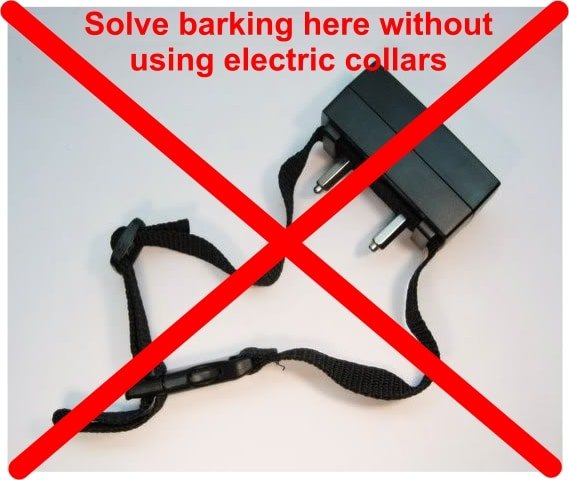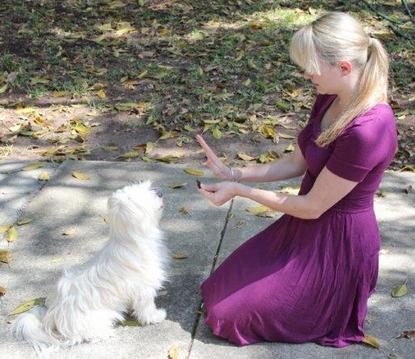My dog is barking when I am home
There are many reasons why your dog could be barking excessively when you are home with him or her.
Firstly though, keep in mind that barking is nothing other that a ‘noise’ your dog makes.
Sometimes that noise means he or she is sad, anxious or unwell. Sometimes the noise means he or she is very happy and excited.
Contents
- Assessing the reason for your dog’s barking
- How can barking be reduced?
- Reducing the access to the stimuli that cause barking
- But my dog does not seem to respond to anything I do!
- Summary
Typically you would be concerned that your dog barks excessively and you can’t reduce that barking with the training techniques you are currently using.
Perhaps your dog is barking at stimuli beyond your fence-line or your dog may be barking at you for attention.
This information will also help if your dog is barking at visitors at your front door.
Curing your dog’s excessive barking is no different from any other behaviour and involves three important chronological steps:-
- Assess your dog’s problem first
- Then implement the solutions that target the problems you identify in your assessment
- Then re-assess your progress as times goes on to ensure you are getting to where you want to be.

Of course, if your neighbours are complaining or your local Council are involved, they don’t care too much about the reason – they just want your dog to shut up.
So, before we start on the solutions, one word of warning.
Be very careful if you are considering using a barking collar. The barking collar also doesn’t care why your dog is making the noise. It will just attempt to punish every single noise your dog makes and ignores the underlying reason. Is that the way you want to go about the solution?
I doubt it!
Read on and become immersed in the simple science of behaviour management using targeted solutions for well-defined problems – in this case, barking when you are home with your dog.

Assessing the reason for your dog’s barking
Let’s get the first step underway and assess the nature of the barking your dog is exhibiting.
For that form of barking that occurs when you are with your dog, the following are the most likely reasons.
1. Anxieties and related conditions
The most common cause is likely to be an anxiety-based reaction to a stimulus that ‘worries’ your dog. You will find more information on anxieties and related ’emotions’ of pets on this link but such reactions include:
- Territorial threats where pedestrians, other dogs and unidentified noises occur beyond your property boundary
- Self-protective aggression where your dog feels threatened by nearby activities
- Human-protective aggression where your dog feels that you may be at risk
- An anxiety disorder such as a Generalised Anxiety Disorder where your dog startles easily and is over-reacting to stimuli that most dogs do not react to.
2. Attention-seeking or comfort-seeking
If your dog is barking at you it could well be attention-seeking behaviour which mostly means it wants to play or because he or she is bored. However, your dog may be barking at you for reasons related to aggression so be careful.
Comfort-seeking is different. A dog may bark at you when it is feeling distressed and wants you to help it with that distress – in other words, he or she wants comfort.
To tell the difference, examine the mood of your dog at the time. If he or she looks distressed, sad or agitated it’s likely to be comfort-seeking and not attention-seeking.
3. Compulsive barking
Compulsions are one of the rarer causes of barking. A compulsion is a purposeless behaviour which is often repetitive, and can occur for long periods. For dogs, compulsive barking often fits into a rhythm and is usually not caused by an identifiable stimulus. Dogs with compulsive disorders need professional attention and the best first step is to contact us for assistance.
4. Old dogs and barking behaviour
Some old dogs bark when they have a senile behaviour disorder similar to Alzheimer’s Disease. This usually occurs with dogs in their ‘teens’. For dogs this is called Canine Cognitive Disorder. There are many methods to reduce the effect of this condition (follow the previous link) but it’s one where your veterinarian will need to be involved.
5. Boredom-related problems
If your dog is an outside dog and does not spend much time with you, then the barking could be based on boredom.
Dogs need activity, guidance and leadership and one problem with ‘outside-only’ dogs is that you have far less opportunity to direct your dog’s behaviour to proper outcomes.
The solution is to provide boredom relief and to ensure your dog has activities to entertain him or her. Click here for our No Bored Dogs Pet Pick.
How can barking be reduced?
There are many ways to limit a dog’s barking behaviour but the most effective methods are those that treat the underlying reason for the barking.
Because you are reading this page, you are home when the barking is occurring so the therapies are usually very different to the processes you use when you are away from home.
So, the therapies for ‘at home’ barking mostly rely on:-
- Reducing the access to the stimuli that cause barking
- Setting a limit to the amount of barking you will allow
- Using reward-based therapies to strengthen quiet behaviour when you achieve it.
- And treating any underlying anxiety disorder, compulsive condition or medical condition if it’s present
Sadly, most dog owners rely on punishment to control barking.
When punishment-based methods are used to reduce an unwanted behaviour, they usually slow down the ability of a dog to learn the alternative good behaviours. Even the most intelligent dog is still fairly dumb compared to humans! When a dog is aroused by stimuli that cause barking it quickly loses the ability to learn and to remember the new techniques you are attempting to teach it.

Better be Better Behaved
4 Key Points that will Solve a Pet's Behavioural Problems When a pet's behaviour goes astray, the results affect the whole family. Those of us who love our pets regard them with the same kinship as we do our own children. Therefore, behavioural problems with pets can...

Parking barking
Your quick and easy DIY guide to barking solutions Do you get 'poison pen' letters in the mailbox, council officers knocking at the door and irate neighbours pointing the finger over the fence - all saying 'Stop the barking!!' Thankfully, taking just six easy steps...

Punishment does not show your dog what it should do instead of barking. So, he or she is likely to then become confused. In most cases where punishment is used, while the dog may stop the barking temporarily, it often resumes again a short moment later. Clearly, your dog doesn’t get the message. For more information on the science behind creating mood changes and problems with punishment view this vitally important sheet “Changing Moods”.
When you change your target and focus on creating silence and rewarding that, the dog can then see the alternatives. Behaviours that are clearly rewarded are more likely to be harvested again. Rewarding a wanted behaviour is like adding fertiliser to a seed you have planted. The behaviour will grow and flourish.
Punishing behaviour is like using weed killer. That weed may wilt but will either recover or other weeds will quickly sprout and require further remedies.
Reward-based solutions usually involve pre-teaching the dog the sequence of commands and actions you will utilise when barking occurs. This pre-teaching is best done in a game-play situation inside your own home – away from the location of barking.
When the dog has learnt the sequence, the game can then be moved to the location or situation where the barking occurs.
For instance, you may start the sequence by game-playing in your lounge room. Then in a few days, move your dog to the front or back fence or maybe your front door and use the same game-playing sequence to rehearse the words in this new location.
The sequence we often used is called the Circle of Rewards and relies on a simple sequence of human words (such as “Leave –Come –Sit”) that your dog is taught to understand by using reward-based training combined with calming strategies.
In human terms, this is called Cognitive Behaviour Therapy. In dog terms this is best summarised by the easier-to-understand term Give a liver treat when your dog gets it right.
Now you need to know how to do all of that.
Easily done -there are full instructions including five clear videos on this facts sheet, The Leave Routine which explains all of that in detail.
Reducing the access to the stimuli that cause barking
If you reduce your dog’s access to the stimuli that cause barking you will not only reduce the amount of barking but will also stop the self-reinforcement of wrongful behaviour.
Reducing the access can involve many things but in practical terms often means:-
- Altering the fence by changing its construction or location to stop the dog’s vision of passing stimuli (more information)
- Giving the dog alternative ‘stimuli’ to entertain and to absorb its interest. You will find the No Bored Dogs Routine is particularly effective for this. (more information)
But my dog does not seem to respond to anything I do!
Why would a dog not respond to sensible training methods?
Of course that could be because you are not using the techniques properly.
If you think that’s the case, please contact us and we can help you with expert guidance.
However, there could be other reasons.
Some dogs are (to use a human term) ’emotional’ and cannot respond to techniques that are designed to make them ‘non emotional’.
What that really means is that your dog may be over sensitive to those normal challenges to which most dogs do not react.
We see many dogs who are not only anxious but also have an anxiety disorder.
Dogs with such problems seem to react when a ‘butterfly sneezes at the fenceline’.
These dogs normally need professional help but in some cases the use of calming agents can help.
That can include the use of dog pheromone diffusers, sprays or collars.
Some respond to homeopathic preparations.
And some need the assistance of new-vogue medications to create a change in behaviour. (Most of these have almost no side-effects nowadays).
Follow the links above for more information on calming agents but if that seems to fit the problem for your pooch, you should contact us for more advice.
Summary
Excessive barking stems from many causes and it is wrong to presume that all cases of barking can be solved with one strategy. However humane solutions do work.
- Remove your dog’s access to the stimuli that cause barking.
- Use reward-based targeted strategies to ensure you are rewarding silent behaviour
- And use calming agents if they are needed – seek professional advice for that
For assistance with your dog’s barking behaviour, get started by completing thi Assessment Form.


